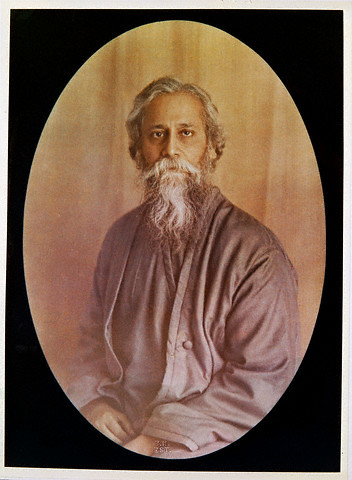
Tagore was not only a creative genius, he was a great man and friend to many. For instance, he was also a good friend from childhood to the great Indian Physicist, Bose. He was educated and quite knowledgeable of Western culture, especially Western poetry and Science. This made him a remarkable person, one of the first of our planet to combine East and West, and ancient and modern knowledge. Tagore had a good grasp of modern - post-Newtonian - physics, and was well able to hold his own in a debate with Einstein in 1930 on the newly emerging principles of quantum mechanics and chaos. His meetings and tape recorded conversations with his contemporaries such Albert Einstein and H.G. Wells, stand as cultural landmarks, and show the brilliance of this great man. Although Tagore is a superb representative of his country - India - the man who wrote its national anthem - his life and works go far beyond his country. He is truly a man of the whole Earth, a product of the best of both traditional Indian, and modern Western cultures. The School of Wisdom is proud to have him as part of its heritage. He exemplifies the ideals important to us of Goodness, Meaningful Work, and World Culture.
Rabindranath Tagore's creative output tells you a lot about this renaissance man. The variety, quality and quantity are unbelievable. As a writer, Tagore primarily worked in Bengali, but after his success with Gitanjali, he translated many of his other works into English. He wrote over one thousand poems; eight volumes of short stories; almost two dozen plays and play-lets; eight novels; and many books and essays on philosophy, religion, education and social topics. Aside from words and drama, his other great love was music, Bengali style. He composed more than two thousand songs, both the music and lyrics. Two of them became the national anthems of India and Bangladesh. In 1929 he even began painting. Many of his paintings can be found in museums today, especially in India, where he is considered the greatest literary figure of India of all times.

Rabindranath Tagore, mystic, painter and Nobel laureate for literature is among the leading personalities of modern Bangladesh & India.
His father, Debendranath Tagore, was a Sanskrit scholar and a leading member of the Brahmo Samaj. Rabindranath's early education was imparted at home. In school, while others use to learn their lessons, he would slip into more exciting world of dreams. Inspired by his older nephew, he wrote his first poem when he was hardly seven. At the age of seventeen, his first book of poems was published.


Tagore was awarded the Nobel Prize in 1913 for his book Gitanjali. W.B.Yeats in particular was deeply impressed with this work and wrote an introduction. With this honour Tagore became famous in both India and the West. In 1915 Tagore was knighted by King George, however Tagore was to return his knighthood in protest of the Amritsar massacre (1919)
Although Tagore stayed out of politics he remained a good friend of Gandhi. In fact it was Tagore who would often persuade Gandhi to give up his fasts in the interest of the nation.
As a writer, Tagore primarily worked in Bengali, but after his success with Gitanjali, he translated many of his other works into English. He wrote over one thousand poems; eight volumes of short stories; almost two dozen plays and play-lets; eight novels; and many books and essays on philosophy, religion, education and social topics.
As well as literature Tagore had a great love of music, in particular Bengali music. He composed more than two thousand songs, both the music and lyrics. Two of them became the national anthems of India and Bangladesh.
Tagore was not just a poet but also productive in the fields of art, music and education. Tagore played a large role in the artistic and cultural renaissance of India which occured in the 20th Century.
A project dear to the heart of Tagore was his school Santiniketan. Tagore tried to fuse the best of Western and Eastern values. Fusing the spirituality of the East with the scientific progress of the West.

No comments:
Post a Comment